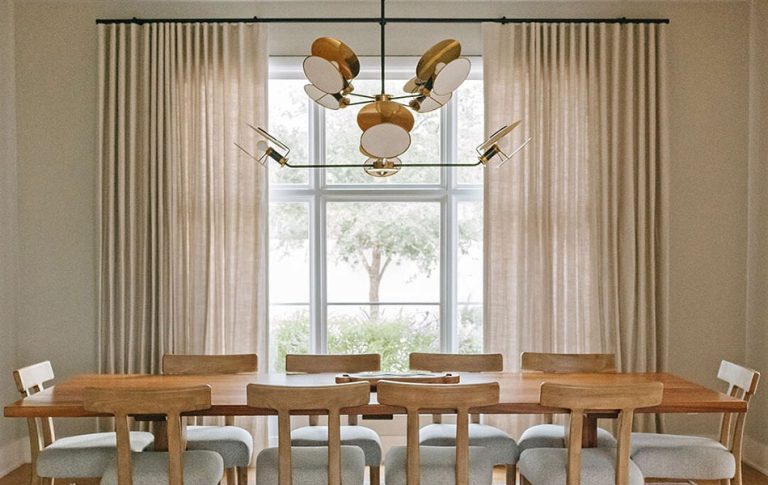The Ultimate Guide: How to Measure for Curtains Like a Professional Designer

You’ve found the perfect fabric. You’ve agonized over colors and textures. But even the most beautiful curtains in the world can fall flat if they’re not measured correctly. Ill-fitting curtains are the silent saboteur of interior design—they can make a room feel awkward, shorten your ceilings, and fail to function as intended.
The process of "how to measure for curtains" is often reduced to a quick width-and-height check. But what if we told you it’s a strategic art form? It’s the crucial bridge between a good room and a great one. This isn't just about getting a number; it's about understanding proportion, light, and illusion to create a space that feels both intentional and inviting.
Forget the anxiety of getting it wrong. This definitive guide will walk you through every step, every consideration, and every professional secret to ensure your next curtain installation is flawless. Grab your tape measure and a notepad; we’re about to transform your windows.
Part 1: The Preliminaries - Gearing Up and Making Key Decisions
Before you extend that metal tape, success lies in preparation. Rushing to measure without answering these foundational questions is the most common mistake.
1.1 Gather Your Tools
You'll need:
- A sturdy steel tape measure (a fabric one can stretch and warp).
- A pencil and notepad or your phone for notes.
- A step ladder for reaching high points safely.
- Patience. Measure twice, even three times, to ensure accuracy.
1.2 Choose Your Curtain Rod or Track First
This is non-negotiable. The rod's style, diameter, and mounting style (inside vs. outside mount) dictate all your measurements.
- Decorative Rods: Typically thicker and extend further from the wall. They are meant to be seen.
- Discreet Tracks: Often minimalist, can be ceiling-mounted, and are designed to be hidden by the curtain header.
1.3 The Great Debate: Inside Mount vs. Outside Mount
This single decision will define your measuring approach.
Inside Mount:
- What it is: The curtain rod is mounted inside the window frame.
- The Look: Clean, modern, and built-in. Excellent for showcasing beautiful trim work on the window.
- The Caveat: Requires sufficient depth inside the recess for the rod and for the curtains to stack back without obstructing the window. Always check depth before committing.
Outside Mount:
- What it is: The curtain rod is mounted on the wall or ceiling above and outside the window frame.
- The Look: Classic, dramatic. It can make a window appear larger and is ideal for windows with insufficient recess depth.
- The Illusion: This is your secret weapon for correcting awkwardly sized or placed windows.
1.4 Define Your Curtain's Purpose
Are these curtains purely for decoration, or do they need to block out light for sleep? Your purpose influences fullness and lining.
- Decorative (Sheer): Light and airy, meant to filter light and provide privacy.
- Functional (Blackout): Need to be wide enough to meet in the middle and block light effectively.
- Room Darkening: A balance between the two, often with a tighter weave.
Part 2: The Master Class - How to Measure for Curtains, Step-by-Step
Now, let's get to the core of "how to measure for curtains." We'll break it down by mount type.
2.1 How to Measure for an INSIDE MOUNT
The goal here is precision. The curtains should fit snugly within the recess without rubbing or getting stuck.
Step 1: Measure the WIDTH
- Measure the width of the window recess at the top, middle, and bottom.
- Use the smallest of these three measurements. This ensures your curtain won't get caught on any part of the frame.
- Do NOT add any extra for fullness at this stage. This is the rod width, not the fabric width.

Step 2: Measure the LENGTH
- Measure from the top of the inside recess down to the point where you want the curtain to end.
- Ending Points:
- Sill Length: Hovers ¼" above the windowsill for a crisp look.
- Apron Length: Extends 4-6" below the sill, perfect for windows with a radiator or deep sill.
- Floor Length: Ends ½" to 1" above the floor for a standard, clean finish.
- Puddle Length: Adds 3" to 12" of extra fabric that pools on the floor for ultimate drama (best for formal rooms and low-traffic areas).



Step 3: The Crucial Depth Check
- Measure the depth of your window recess from the front to the back.
- Ensure this depth can accommodate your chosen curtain rod and allow the curtains to stack back without pressing against the window glass or frame. A minimum of 3 inches is often safe, but check your rod brackets.
2.2 How to Measure for an OUTSIDE MOUNT
This is where you take control and create optical illusions. The measurements are more about your desired visual impact.
Step 1: Plan Your Rod Placement (Width)
- For optimal light control and to make the window appear larger, the rod should extend 8 to 15 inches beyond the window frame on each side.
- This allows the curtains to be pulled completely off the glass, flooding the room with light.
- A good rule of thumb: The rod should be at least 8-10 inches wider than the window frame in total.
Step 2: Measure the ROD WIDTH
- This is the final length of the rod you will purchase. It is the measurement from one end of the rod to the other, excluding the finials.
Step 3: Plan Your Rod Placement (Height)
- To create the illusion of taller ceilings, mount the rod 4 to 6 inches above the top of the window frame. For truly dramatic, floor-to-ceiling impact, mount the rod just below the ceiling or crown molding.
- This draws the eye upward, instantly elevating the space.
Step 4: Measure the LENGTH
- Measure from the top of where the rod will be (not the bracket, but the very top of the rod) down to your desired endpoint (sill, apron, floor, or puddle).
- Pro Tip: If you want the "floating" look (½" above the floor), measure in multiple spots across the window area. Floors are rarely perfectly level, so use the shortest measurement to ensure the curtain never actually touches the floor.
Part 3: From Raw Measurements to Perfect Order - Calculating Fullness & Final Numbers
You have your rod width and length. But these are not the numbers you give to the curtain maker or retailer. Now, we calculate fabric requirements.
3.1 The Magic of Fullness: Why Your Curtains Need "Gather"
A flat curtain is a sad curtain. Fullness is the ratio of the total width of the fabric to the width of the rod. It creates those beautiful, luxurious folds (pleats) when the curtains are closed.
- Standard Fullness: A ratio of 2:1. This means for every foot of rod width, you need 2 feet of fabric.
- Luxury Fullness: A ratio of 2.5:1 or even 3:1. This creates denser, more opulent folds, highly recommended for heavier fabrics and a high-end look.
The Formula:
Total Fabric Width = Rod Width x Desired Fullness Ratio (e.g., 2 or 2.5)
- Example: Your outside-mount rod is 100 inches wide. For standard fullness: 100" x 2 = 200 inches of total fabric width. Since most curtains are sold in pairs, you would order two panels, each needing to be at least 100 inches wide after seaming.
3.2 Header Styles and Length Calculations
The top part of the curtain (the header) affects the final hanging length.
- Rod Pocket: The fabric length is measured from the top of the pocket to the hem. Simple, but can be difficult to slide.
- Back Tab/Hidden Tab: The finished length is measured from the top of the fabric. This creates a "floating" effect as the tabs are hidden behind.
- Grommet/Eyelet: The finished length is measured from the top of the ring. This style uses a fixed amount of fabric for the grommets, so it's usually consistent.
- Pin Hook/Pleated Hooks (e.g., French Pleat): This is the most critical. Hooks are inserted into the back of the pleated header. The finished length is measured from the bottom of the ring on the rod to the hem. You must account for the space the header takes up below the rod. Always check with your manufacturer for the "stack height" or "from the bottom of the ring" measurement.
Part 4: Advanced Scenarios & Professional Problem-Solving
Not every window is a standard rectangle. Here’s how to handle the tricky ones.
4.1 Bay Windows
Bay windows require a flexible track that can be bent to the window's angle.
- Measuring: Measure the length of each individual window section along the track.
- Fullness: Calculate fullness for the total track length.
- Installation: Typically, you'll have multiple curtains on one continuous track that glide around the bends.
4.2 Corner Windows
Treat two corner windows as one continuous span. Mount one long rod that covers both windows, leaving space in the corner for the curtains to stack back without blocking either window.
4.3 French Doors & Sliding Glass Doors
- Use a bypass rod or a top-down/bottom-up style to allow for operation without the curtains getting in the way.
- Measure from the top of the door to the floor, and ensure the rod extends beyond the door frame so the curtain can be pulled completely aside.
Part 5: The Final Checklist & Common Pitfalls to Avoid
Before you place your order, run through this list.
- I have chosen my rod/track.
- I have decided on Inside or Outside Mount.
- I have measured the WIDTH correctly (smallest measurement for inside, planned extension for outside).
- I have measured the LENGTH correctly from the correct starting point (top of recess for inside, top of rod for outside).
- I have accounted for my header style (especially for pin-hook styles).
- I have calculated FABRIC WIDTH using the fullness formula (Rod Width x 2).
- I have chosen my hem length (Sill, Apron, Floor, Puddle).
- I have measured twice (or three times!).
Common Pitfalls:
- The "Puddle" in a High-Traffic Area: Creates a tripping hazard and collects dust.
- Curtains That are Too Short: "High-waters" for your window. It’s the most common design mistake. When in doubt, go longer.
- Curtains That are Too Narrow: They look skimpy and can't close properly, defeating their purpose.
- Ignoring the Rod: A flimsy, too-thin rod can make even the best curtains look cheap.
Conclusion: Measure with Vision, Install with Confidence
Learning how to measure for curtains is more than a mechanical task—it's the first and most important act of window styling. It’s the difference between a window that’s merely covered and a window that’s beautifully framed. By understanding the principles of mounting, fullness, and proportion, you empower yourself to not just follow instructions, but to create.
You now possess the knowledge to walk into any room, assess any window, and know exactly how to dress it for success. So take your time, trust your tape, and get ready to hang curtains that don't just fit your windows, but transform your rooms.






